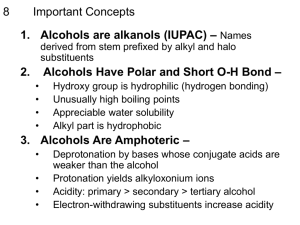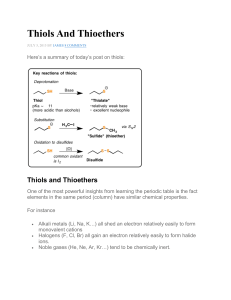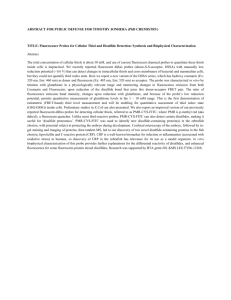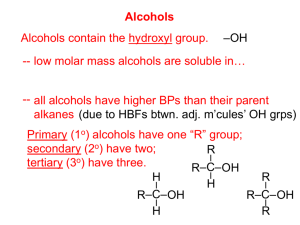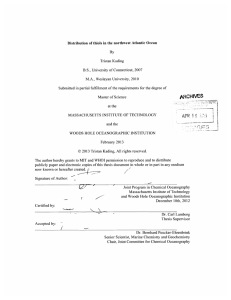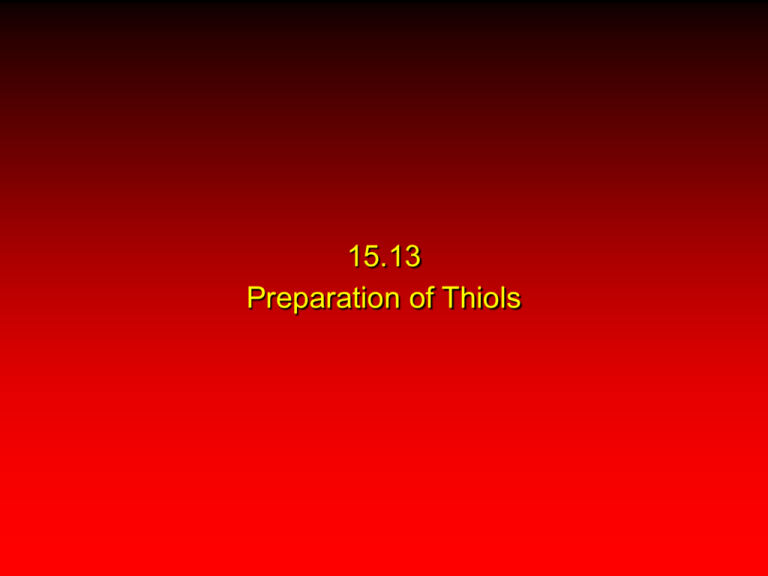
15.13
Preparation of Thiols
Nomenclature of Thiols
1) analogous to alcohols, but suffix is -thiol
rather than -ol
2) final -e of alkane name is retained, not
dropped as with alcohols
Nomenclature of Thiols
1) analogous to alcohols, but suffix is -thiol
rather than -ol
2) final -e of alkane name is retained, not
dropped as with alcohols
CH3CHCH2CH2SH
CH3
3-Methyl-1-butanethiol
Thiols are prepared from alkyl halides
••
••
H2N ••
C
H2N ••
••
••
S
••
H2N +
+
R
X
C
••
S
••
R
H2N ••
••
SN2 using thiourea as source of nucleophilic
sulfur
the product is an isothiouronium salt
Thiols are prepared from alkyl halides
••
••
H2N ••
C
H2N ••
••
••
O
••
••
+ HS
••
R
NaOH
H2O
H2N +
C
••
S
••
R
H2N ••
••
hydrolysis in base converts the isothiouronium salt
to the desired thiol
Example
1. (H2N)2C S
CH3(CH2)4CH2Br
2. NaOH
CH3(CH2)4CH2SH
1-Hexanethiol (84%)
15.14
Properties of Thiols
Properties of Thiols
1. low molecular weight thiols have foul odors
2. hydrogen bonding is much weaker in thiols than
in alcohols
3. thiols are stronger acids than alcohols
4. thiols are more easily oxidized than alcohols;
oxidation takes place at sulfur
Thiols are stronger acids than alcohols
have pKas of about 10; can be deprotonated in
aqueous base
••
RS
••
– ••
H + •• OH
stronger acid
(pKa = 10)
••
•• –
RS ••
••
+
H
••
OH
••
weaker acid
(pKa = 15.7)
Oxidation of thiols take place at sulfur
••
RS
••
thiol
H
••
RS
••
••
SR
••
disulfide
thiol-disulfide redox pair is important in
biochemistry
other oxidative processes place 1,2, or 3
oxygen atoms on sulfur
Oxidation of thiols take place at sulfur
••
RS
••
H
thiol
••
RS
••
••
SR
••
disulfide
•• –
•• O ••
••
RS
••
OH
sulfenic acid
+
RS OH
••
sulfinic acid
•• –
•• O ••
2+
RS
OH
•• O ••
••
–
sulfonic acid
Example: sulfide-disulfide redox pair
SH
O
HSCH2CH2CH(CH2)4COH
O2, FeCl3
S
S
O
(CH2)4COH
a-Lipoic acid (78%)
15.15
Spectroscopic Analysis of Alcohols
Infrared Spectroscopy
O—H stretching: 3200-3650 cm–1 (broad)
C—O stretching: 1025-1200 cm–1 (broad)
Figure 15.4: Infrared Spectrum of Cyclohexanol
OH
C—H
O—H
C—O
3500
3000
2500
2000
1500
1000
Wave number, cm-1
Francis A. Carey, Organic Chemistry, Fourth Edition. Copyright © 2000 The McGraw-Hill Companies, Inc. All rights reserved.
500
1H
NMR
chemical shift of O—H proton is variable; depends
on temperature and concentration
O—H proton can be identified by adding D2O; signal
for O—H disappears (converted to O—D)
H—C—O signal is less shielded than H—C—H
H
d 3.3-4 ppm
C
O
H
d 0.5-5 ppm
Figure 15.5 (page 607)
CH2CH2OH
10.0
9.0
8.0
7.0
6.0
5.0
4.0
3.0
Chemical shift (d, ppm)
2.0
1.0
0
13C
NMR
chemical shift of C—OH is d 60-75 ppm
C—O is about 35-50 ppm less shielded than C—H
CH3CH2CH2CH3
d 13 ppm
CH3CH2CH2CH2OH
d 61.4 ppm
UV-VIS
Unless there are other chromophores in the
molecule, alcohols are transparent above
about 200 nm; lmax for methanol, for
example, is 177 nm.
Mass Spectrometry of Alcohols
molecular ion peak is usually small
a peak corresponding to loss of H2O
from the molecular ion (M - 18) is
usually present
peak corresponding to loss of an
alkyl group to give an oxygenstabilized carbocation is usually
prominent
Mass Spectrometry of Alcohols
molecular ion peak is usually small
R
a peak corresponding to loss of H2O
from the molecular ion (M - 18) is
usually present
peak corresponding to loss of an
alkyl group to give an oxygenstabilized carbocation is usually
prominent
R
R•
CH2
••
OH
••
•+
CH2
OH
CH2
+
OH
••
••

